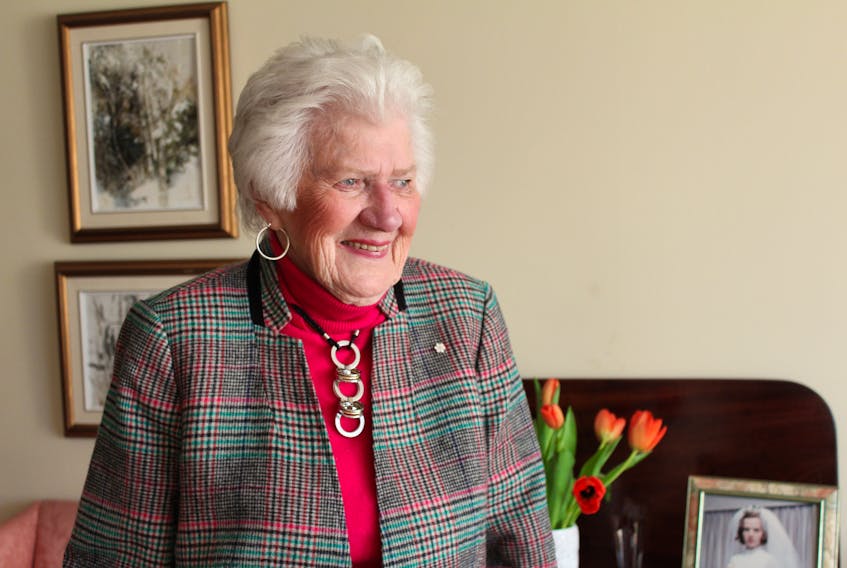Editor’s note: The one thing we all have in common is that we’re getting older by the day, and as we age, our priorities and lifestyles change.
In time, many of us will have to deal with similar issues — staying independent and active, maintaining a social life, getting involved (or staying involved) in volunteer work and community advocacy, finding the right housing fit for our lifestyles, and making the transition to retirement.
In this six-part series, The Telegram’s Ashley Fitzpatrick talks to people about what they’ve learned from their own experiences.

Margot Reid is a hard woman to pin down, active morning, noon and night, she says, and is in no fear of falling into social isolation. She holds positions on multiple boards of directors and volunteering plays a significant role in her schedule, as it has for many years.
She believes it’s essential for people to keep mind and body active as the years tick on. Her volunteering is a part of that effort for herself. It’s also ingrained, at this point.
She knows it’s not for everyone and she’s not convinced large numbers of people in Newfoundland and Labrador would suddenly start volunteering simply because someone suggests it. People may not be interested, or they may face barriers.
“They had a function the other night — black dress, which I went to and was a lot of fun. It was amazing it was so much fun.” — Margot Reid on the social aspect of volunteering
“If they haven’t volunteered through the years. … Are they going to start now?” the 91-year-old mused, when presented with the idea there could be social and mental health benefits to having more people volunteering post-retirement.
But Reid generally encourages volunteerism, for all ages. Among other things, she has been recognized as the longest-serving volunteer in the country with the Canadian Cancer Society.
Her father-in-law was the first chairman of the board of the Newfoundland Cancer Society and encouraged her to volunteer when she returned to the island from training as a nurse at Royal Victoria Hospital in Montreal. “He thought that it was a good idea for me to become a volunteer,” she said, recalling signing up with what is now the local branch of the Canadian Cancer Society.
Throughout 68 years with the organization so far, the work has changed. Promoting spring flower sales remains a part of her annual efforts, but she used to do more house-to-house work before the accommodations for cancer patients at Daffodil Place in St. John’s were established.
“When I first went, we got groups together that made bandages. Because we just — I don’t know why, but I guess they weren’t made in the hospitals,” she recalled. “And if we had squares and so on we packaged those up and patients came and collected them. So, it’s changed, changed, changed in so many years.”
She continues to offer her time, in part, because the organization has proven flexible in how an individual can contribute, and efforts are shared amongst volunteers. “I still do the driving (of patients to the Dr. H. Bliss Murphy cancer treatment centre) when they call me,” she said.
She’ll drive patients to appointments, with conversation along the way. “And I help Cancer Society in all kinds of different areas, with other volunteers, which is rather nice. You meet new people so I try and support them in almost every activity that they have.”
The organization also acknowledges its volunteers, which she appreciates.
“They had a function the other night — black dress, which I went to and was a lot of fun. It was amazing it was so much fun,” she said.
In the United Kingdom, the Centre for Ageing Better gathered academic research, case studies and individual testimonials, and issued a report in October 2018 on age friendly and inclusive volunteering. Among other things, it promoted the idea that organizations not focus on any single demographic and work to make it easier for all people to participate.
“Many of the things that get in the way of getting involved later in life also create barriers for younger people — practical issues like the cost of participation, and structural issues like time and bureaucracy entailed in getting involved,” it noted, while encouraging groups to look beyond the “civic core,” the individuals who are relied on by multiple organizations in a community.
The centre categorized barriers to volunteering as practical, structural and emotional. Practical barriers include things like a lack of accessibility to regular venues, or associated costs (including when volunteers would feel pressured to spend money). That could be gatherings where ticket sales are targeted at volunteers, assigned duties where travel is expected to be paid out-of-pocket, or popular thank-you events where paying for drinks is expected of volunteers. If you can’t pay, it’s easy to feel like an outsider.
Structural barriers would include excessive time commitments, the either-or demand that people set aside what amounts to more than they can give or nothing at all. There is also the idea of relying on a faith-based institution for meeting space, and people not necessarily feeling it’s really for them.
In terms of emotional barriers, there are fears of being over-committed, of not being able to maintain flexibility in your schedule. And there is the fear of encountering agism.
As an example, it’s not a given that simply because someone is a retiree that they have time to volunteer, just because many volunteers happen to be retirees.
“The review encountered worrying complacency among many volunteer-involving organizations about the involvement of people in later life in volunteering,” it stated, “perhaps informed by the current profile of the civic core.”
RELATED
- GETTING OLDER: Staying in the game
- GETTING OLDER: The drive for independence
- GETTING OLDER: Somebody to lean on
Factbox: 4 tips for attracting and retaining volunteers
- Let people know they’re needed — from coffee shop notice boards to social media to traditional advertising. People are more likely to volunteer if they know they’re needed and they have some sense of what to expect before making contact. They’re more likely to stay if the tasks are aligned with their personal strengths — anyone not comfortable with small talk might prefer to help stock shelves versus speak to clients at a food bank, for example.
- Offer flexibility — In scheduling, in number of hours, in available tasks. The more options you can offer people, the more likely they are to find a contribution they can make to help. And since lives change in a snap, giving regular opportunities for people to change tasks and time commitments can also be the difference between keeping a regular volunteer and losing them.
- Buddy up and train right — throwing people into tasks, particularly in the middle of a group of people who already know each other well, can be alienating. Try to offer a buddy or a mentor, someone to work beside or at least consult in the early days. Make sure they’re accessible and not a mentor in name only.
- Make it fun — provide an opportunity to work in groups, socialize and connect when possible. If someone feels they get more out of a morning at the local coffee shop, that’s likely where they’ll opt to go. And offer simple thank yous — anything from a card of thanks to a nod in a newsletter. It doesn’t need to be a big party to be meaningful.









